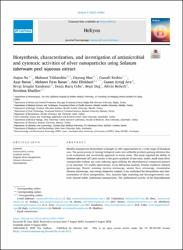| dc.contributor.author | Xu, Jiajun | |
| dc.contributor.author | Yıldıztekin, Mahmut | |
| dc.contributor.author | Han, Dayong | |
| dc.contributor.author | Keskin, Cumali | |
| dc.date.accessioned | 2023-09-25T08:45:13Z | |
| dc.date.available | 2023-09-25T08:45:13Z | |
| dc.date.issued | 2023 | en_US |
| dc.identifier.citation | Xu, Jiajun, Mahmut Yıldıztekin, Dayong Han, Cumali Keskin, Ayşe Baran, Mehmet Fırat Baran, Aziz Eftekhari et al. "Biosynthesis, characterization, and investigation of antimicrobial and cytotoxic activities of silver nanoparticles using Solanum tuberosum peel aqueous extract." Heliyon 9, no. 8 (2023). | en_US |
| dc.identifier.issn | 2405-8440 | |
| dc.identifier.uri | https://doi.org/10.1016/j.heliyon.2023.e19061 | |
| dc.identifier.uri | https://hdl.handle.net/20.500.12809/10977 | |
| dc.description.abstract | Metallic nanoparticle biosynthesis is thought to offer opportunities for a wide range of biological uses. The green process of turning biological waste into utilizable products gaining attention due to its economical and eco-friendly approach in recent years. This study reported the ability of Solanum tuberosum (ST) peel extract to the green synthesis of non-toxic, stable, small-sized silver nanoparticles without any toxic reducing agent utilizing the phytochemical components present in its structure. UV-visible spectroscopy, X-ray diffraction analysis, Fourier transform infrared spectroscopy, flourier scanning electron microscopy, atomic force microscopy, transmission electron microscopy, and energy dispersive analysis X-ray confirmed the biosynthesis and char-acterization of silver nanoparticles. Also, dynamic light scattering and thermogravimetric ana-lyses showed stable synthesized nanoparticles. The antibacterial activity of the biosynthesized silver nanoparticles was evaluated against four different bacterial strains, Escherichia coli (E. coli), Pseudomonas aeruginosa (P. aeruginosa), Staphylococcus aureus (S. aureus) Bacillus subtilis (B. subtilis), and a yeast, Candida albicans (C. albicans) using the minimum inhibitory concen-tration technique. The cytotoxic activities were determined against Human dermal fibroblast (HDF), glioblastoma (U118), colorectal adenocarcinoma (CaCo-2), and human ovarian (Skov-3) cell lines cancer cells using MTT test. The nanoparticle capping agents that could be involved in the reduction of silver ions to Ag NPs and their stabilization was identified using FTIR. Nano -particles were spherical in shape and had a size ranging from 3.91 to 27.07 nm, showed crys-talline nature, good stability (-31.3 mV), and the presence of capping agents. ST-Ag NPs significantly decreased the growth of bacterial strains after treatment. The in vitro analysis showed that the ST-Ag NPs demonstrated dose-dependent cytotoxicity against cell lines. Based on the data, it is feasible to infer that biogenic Ag NPs were capped with functional groups and demonstrated considerable potential as antibacterial and anticancer agents for biomedical and industrial applications. | en_US |
| dc.item-language.iso | eng | en_US |
| dc.publisher | ELSEVIER SCI LTD | en_US |
| dc.relation.isversionof | 10.1016/j.heliyon.2023.e19061 | en_US |
| dc.item-rights | info:eu-repo/semantics/openAccess | en_US |
| dc.subject | Antimicrobial activity | en_US |
| dc.subject | Cytotoxic activity | en_US |
| dc.subject | Biogenic silver nanoparticles | en_US |
| dc.subject | Solanum tuberosum L. | en_US |
| dc.subject | Nanomedicine | en_US |
| dc.title | Biosynthesis, characterization, and investigation of antimicrobial and cytotoxic activities of silver nanoparticles using Solanum tuberosum peel aqueous extract | en_US |
| dc.item-type | article | en_US |
| dc.contributor.department | MÜ, Köyceğiz Meslek Yüksekokulu, Bitkisel Ve Hayvansal Üretim Bölümü | en_US |
| dc.contributor.authorID | 0000-0002-0206-0117 | en_US |
| dc.contributor.institutionauthor | Yıldıztekin, Mahmut | |
| dc.identifier.volume | 9 | en_US |
| dc.identifier.issue | 8 | en_US |
| dc.relation.journal | HELIYON | en_US |
| dc.relation.publicationcategory | Makale - Uluslararası Hakemli Dergi - Kurum Öğretim Elemanı | en_US |


















